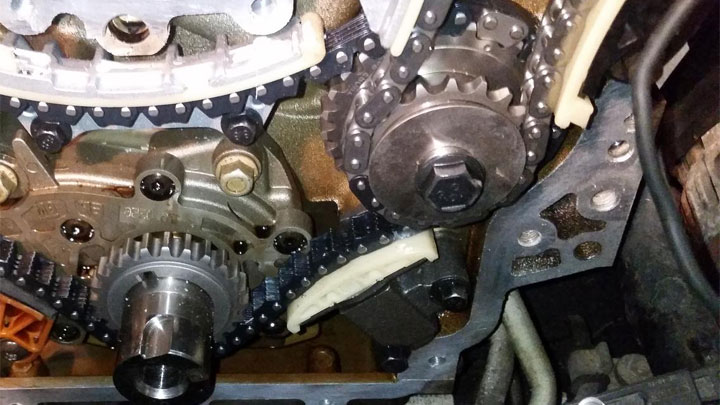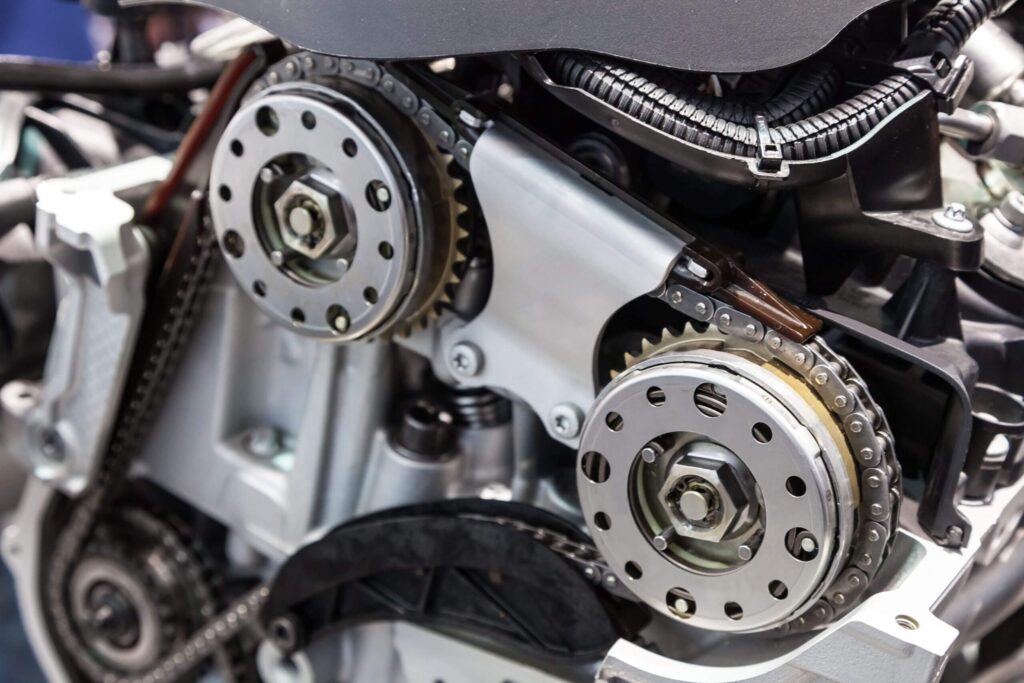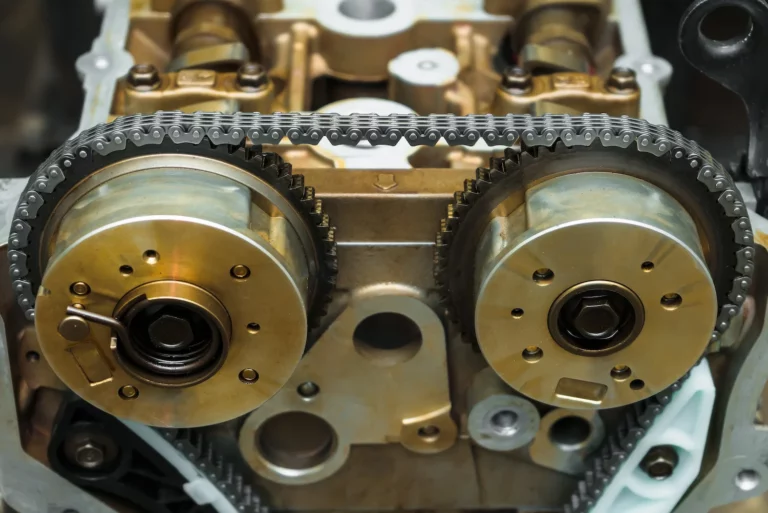Sometimes, a timing chain may fail completely after as little as 20-30 miles (32-48 kilometers) of driving with evident issues. However, the exact distance or time can differ based on factors such as the severity of damage, driving conditions, and engine type.
While the exact mileage or time frame can vary depending on the specific situation, it’s crucial to understand that the risks increase the longer you drive with a failing timing chain.
Signs of a Bad Timing Chain
Recognizing the signs of a bad timing chain is essential for timely intervention and preventing potential engine damage. Let’s explore these warning signals:
Unusual Engine Noises: One of the most common signs of a failing timing chain is unusual engine noises. Listen for:
Rattling or Ticking: A noticeable rattling or ticking sound coming from the engine, especially at idle or during acceleration, can indicate a loose or worn timing chain.
Whining or Whirring: Some vehicles may produce a high-pitched whining or whirring noise when the timing chain is under stress.
Poor Engine Performance: A bad timing chain can impact your engine’s performance in several ways:
Reduced Power: You may notice a significant decrease in engine power and overall performance, particularly when accelerating or climbing hills.
Rough Idling: The engine may idle roughly, causing vibrations and instability at rest.
Misfires: Timing chain issues can lead to misfires, causing the engine to run unevenly and potentially triggering a loss of fuel efficiency.
Check Engine Light and Diagnostic Trouble Codes (DTCs):

Modern cars have a system that turns on the check engine light if it detects a problem. Common diagnostic trouble codes (DTCs) associated with timing chain problems include:
P0016: Crankshaft Position-Camshaft Position Correlation Bank 1 Sensor A
P0017: Crankshaft Position-Camshaft Position Correlation Bank 1 Sensor B
P0018: Crankshaft Position-Camshaft Position Correlation Bank 2 Sensor A
P0019: Crankshaft Position-Camshaft Position Correlation Bank 2 Sensor B
If your check engine light comes on, it’s crucial to have your vehicle scanned for DTCs promptly. Ignoring these warnings can lead your vehicle to more significant timing chain issues over time.
Factors that influence the lifespan of a bad-timing chain
The lifespan of a timing chain can vary significantly depending on several key factors. Let’s delve into these factors with numerical insights:
Type of Engine (Timing Chain vs. Timing Belt): The engine type of your vehicle is important for determining the lifespan of the timing chain:
Timing Chain: Engines equipped with timing chains tend to have a longer-lasting timing system.
Timing chains are designed to endure the life of the engine in many cases, potentially surpassing 200,000 miles (321,869 kilometers) without requiring replacement.
Timing Belt: In contrast, engines equipped with timing belts require more frequent replacement, typically around every 60,000 to 100,000 miles (96,560 to 160,934 kilometers).
Not changing the timing belt on time can harm the engine and lead to expensive fixes.
Severity of Damage to the Timing Chain:
The extent of damage to the timing chain is a crucial factor in its lifespan:
Timely Maintenance: If you address timing chain issues promptly, you may prevent minor problems from escalating. Timely repairs can extend the timing chain’s life.
Ignoring Issues: On the other hand, ignoring signs of wear, such as rattling noises or reduced engine performance, can lead to more extensive damage. Severe damage can require timing chain replacement sooner than expected.
Driving Conditions and Maintenance History:
The way you drive and maintain your vehicle also significantly affects the timing chain’s lifespan:
Driving Conditions: Harsh driving conditions, such as constant stop-and-go traffic, towing heavy loads, or exposure to extreme temperatures, can accelerate timing chain wear.
In such conditions, the chain may require replacement as early as 100,000 miles (160,934 kilometers) or even sooner.
Maintenance History: Regular maintenance, including oil changes and inspections, is essential. A well-maintained vehicle is less likely to experience premature timing chain issues.
You can expect the timing chain to last well beyond 100,000 miles (160,934 kilometers) with proper care.
Risks of Driving with a Bad Timing Chain
While it might be tempting to put off addressing timing chain issues, it’s crucial to understand the potential risks associated with driving a vehicle with a bad timing chain.
Ignoring this critical component’s condition can lead to various problems and hazards. Let’s delve into these risks:
Potential Engine Damage: One of the most significant risks of driving with a faulty timing chain is the potential for severe engine damage. The timing chain ensures the engine’s parts work together smoothly.
If the timing chain fails or slips, the engine’s valves and pistons can collide, causing catastrophic damage.
Valve and Piston Damage: Misalignment between the valves and pistons can result in bent valves, damaged pistons, and even cracked cylinder heads. Repairing this kind of engine damage can be exceptionally costly.
Safety Concerns: A compromised timing chain can also pose safety concerns on the road. A sudden engine failure due to timing chain issues can lead to:
Loss of Power: When the engine fails to function correctly, you may experience a sudden loss of power, making it challenging to control your vehicle.
Stalling: In some cases, a bad timing chain can cause the engine to stall unexpectedly, leaving you stranded in potentially unsafe situations.
Towing and Repair Costs: Driving with a bad timing chain can result in significant towing and repair expenses.
Towing Costs: If your vehicle breaks down due to timing chain failure, you’ll likely need towing services to transport it to a repair facility.
Repair Costs: Repairing or replacing a timing chain is labor-intensive, as it often involves disassembling a significant portion of the engine. The associated costs can be substantial, especially if engine components have sustained damage.
How Long Can You Drive with a Bad Timing Chain Safely?

When faced with a timing chain issue, one common question arises: how long can you safely drive before addressing the problem? Consider the following factors when deciding to drive with a bad timing chain for a long time.
General recommendations from experts:
Daily Limit: Experts recommend limiting your driving to 8-10 hours per day. This includes breaks and rest stops.
Rest Breaks: Take a 15-minute break for every 2 hours of continuous driving to combat fatigue.
Weekly Limit: Avoid exceeding 60-70 hours of driving in 7 days. This is in accordance with regulations for professional truck drivers.
Sleep: Ensure you get 7-9 hours of sleep before a long drive to stay alert.
Hydration: Stay well-hydrated, as dehydration can lead to reduced focus and reaction time.
Healthy Snacks: Opt for healthy snacks to maintain energy levels and avoid excessive caffeine.
Specific situations where it might be riskier:
Night Driving: Nighttime driving can be riskier due to reduced visibility and increased drowsiness. Limit night driving if possible.
Adverse Weather: In adverse weather conditions, such as heavy rain, snow, or fog, it’s safer to reduce your driving time and speed.
Long Commutes: Long daily commutes can increase fatigue. Consider carpooling or using public transportation for lengthy journeys.
Medical Conditions: If you have a medical condition that affects your ability to concentrate or stay awake, consult a healthcare professional and follow their recommendations regarding driving limitations.
Medications: Some medications can cause drowsiness or impair your driving abilities. Read labels and consult your doctor if you are unsure about the effects of your medication.
Stress and Emotional State: High levels of stress, anxiety, or strong emotions can impair your focus and reaction time. Avoid driving when emotionally distressed.
The importance of prompt diagnosis and repair:
Regular Maintenance: Ensure your vehicle undergoes regular maintenance checks to detect and address potential issues early. To prevent engine damage, top up essential fluids like oil, coolant, and brake fluid.
Warning Signs: Pay attention to warning signs like unusual sounds, dashboard warning lights, or changes in vehicle performance. Address these promptly to prevent breakdowns on the road.
Tire Maintenance: Check tire pressure regularly and replace worn-out tires promptly to avoid blowouts.
Brake System: Maintain your brake system to ensure it functions optimally, as brake failure can lead to accidents.
FAQs
What happens if I continue driving with a bad timing chain?
Continuing to drive with a bad timing chain can lead to severe engine damage, including bent valves, damaged pistons, and even engine failure.
Can I drive my vehicle to a repair shop with a bad timing chain?
No, you can’t drive your vehicle to a repair shop with a bad timing chain, as it can cause extensive engine damage.
Are there any symptoms of a bad timing chain?
Yes, there are some symptoms of a bad timing chain, including engine misfires, rattling noises from the engine, loss of power, and poor fuel efficiency.
Can a bad timing chain be repaired, or should it be replaced?
Yes, a bad timing chain typically can be replaced rather than repaired, as it is a critical engine component.
How much does it cost to replace a timing chain?
Replacing a timing chain can cost anywhere from $500 to $1,500 or more. The exact price depends on your car’s make and model, local labor rates, and if other engine parts need replacing.
Can I check the timing chain’s condition myself?
No, you cannot easily check the timing chain’s condition yourself without the appropriate tools and mechanical expertise, as it often requires disassembling the engine for inspection.
What causes a timing chain to go bad?
Timing chains can wear out due to normal use and mileage, but poor maintenance, lack of oil changes, or other engine issues can accelerate their wear.
Is it safe to drive with a loose timing chain?
No, it is not safe to drive with a loose timing chain. A loose chain can lead to timing issues, causing severe engine damage.
Can a bad timing chain affect the engine’s performance?
Yes, a bad timing chain can affect the engine’s performance, leading to poor fuel efficiency, decreased power, and rough running.
How often should a timing chain be replaced as part of maintenance?
Timing chains are designed to last long, and replacement intervals vary by vehicle make and model. They may not need replacement for 100,000 to 200,000 miles or more, depending on the manufacturer’s recommendations and the specific engine.
Conclusion
In summary, it’s crucial to identify signs of a faulty timing chain and be aware of the risks as a responsible car owner.
While providing precise numerical insights on how long you can safely drive with a failing timing chain is challenging due to various factors, the general consensus among experts is clear: once you suspect a timing chain issue, it’s best to stop driving immediately.
The risks of continuing to drive with a bad timing chain include potential engine damage, safety concerns, and increased repair costs.
Ultimately, responsible maintenance and attentive monitoring of your vehicle’s performance can help you identify timing chain problems early, allowing you to address them promptly and maintain your vehicle’s health and peace of mind on the road.

